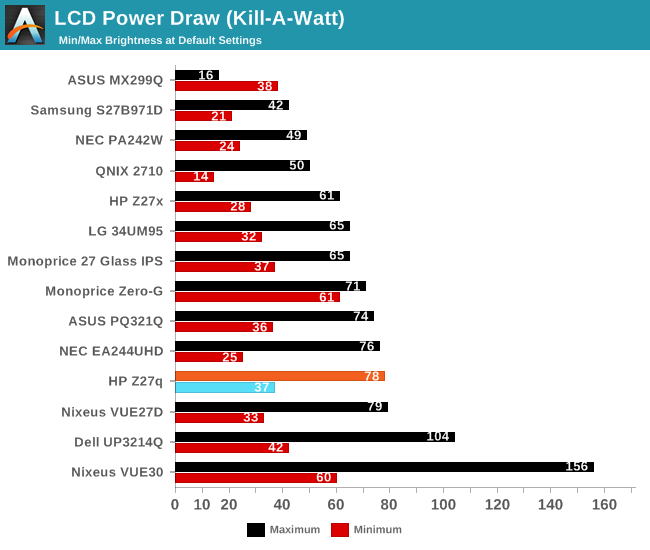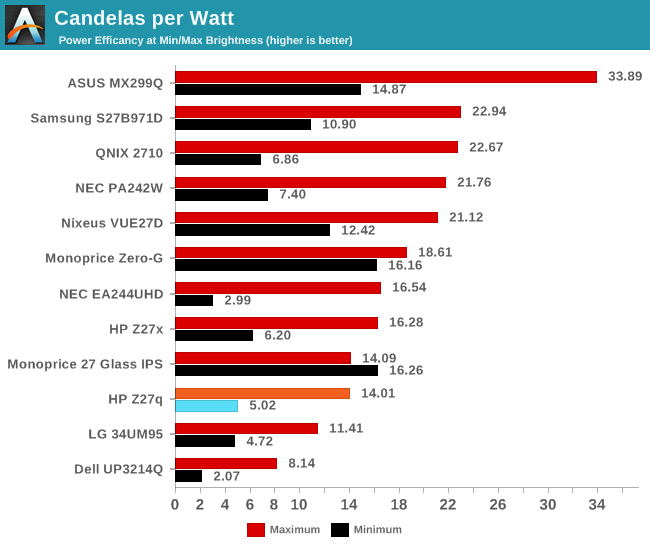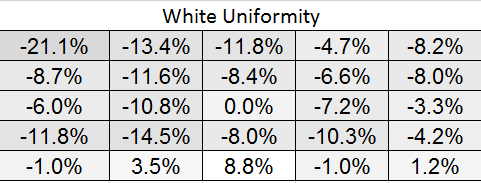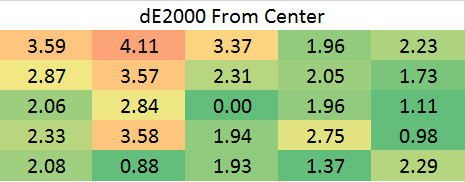HP Z27q Monitor Review: Aiming For More Pixels
by Brett Howse on December 22, 2015 8:00 AM ESTDisplay Uniformity
Having an accurate display is great, but the best displays maintain that accuracy across the entire display. This is challenging for most displays, with larger displays struggling to keep an even backlighting across the entire panel.
White Levels
The HP Z27q suffers from the same issues with uniformity that the Z27x had. There is a significant drop in brightness at the edges of the display. The maximum drop is the upper left corner, where it falls over 20% from the center. The rest of the panel is quite a bit more consistent, but some work could be done here to improve the results.
Black Levels
The black levels are even more inconsistent than the white levels, with the top of the display having the best black levels, and the bottom of the display has the brightest blacks. As a percentage basis, it’s not great.
Color Variation
The error level from the center is, on average, pretty good. There are a couple of areas where the error level is above that of something you would notice, but generally it is pretty close to the same error level as the center. Color uniformity is likely impacted by the same backlight issues that caused the white levels to drop off. Overall, the uniformity results of the Z27q are very similar to the Z27x. There is quite a bit of variation across the panel, and true professionals will likely want a display more accurate than this. At the center, it is very good, but once you move out to the edges, the backlight is quite uneven.
Power Use
Power is measured at the wall with a Kll-A-Watt meter. Measurements are done at both the maximum backlight level, and the minimum backlight level. Maximum brightness is right around 300 nits, and minimum is 51.

The display draws quite a bit of power compared to other 27-inch panels, with a maximum draw of 78 watts at 100% brightness. The minimum power draw is 37 watts, which is once again pretty high. This is not that surprising due to the resolution of this panel, since in order to hit the same brightness levels as a lower resolution display, it is going to need a more powerful backlight due to the transistors in the panel blocking more of the light.
The standby power draw was also quite high. I measured 16 watts at the wall when the display is in standby mode.
Efficiency

Once again, with the high number of pixels, this panel is not going to be as efficient as lower resolution devices. However, it is not as far off as you may think. Candelas per Watt at maximum brightness was 14.01, which is certainly lower than some of the other 27-inch devices, but not excessively so. At minimum brightness the efficiency drops to just 5.02 Candelas per Watt, and more of the power usage is shifted to the electronics of the unit rather than the backlight.















92 Comments
View All Comments
SanX - Monday, December 28, 2015 - link
I am surprized that you have started arguing having no slightestclue in the main basic thing of monitors. It is not the screen 103PPI what
matters but perceived PPI based on resolved angular dimensions of the pixels.
This and other factors also define optimal viewing distance.
The optimal distances are set by the TXH and SMPTE standards
and not the length of your legs. For 4K monitors perceived PPI are
almost whopping 600 and head turning 717 respectively. This makes 43"
TV too small for normal PC use and you have to put it closer to your
nose to utilize this excessive PPI. That in turn what causes discomfort,
and that is why you need larger size TV. Where Anandtech finds such
technodumbos like you? If you will start scaling PPI to be able see
the small fonts clearly that means trashing all 100% of spent money
on your "arguably better quality IPS panel" because those small scaled
fonts look uglier then on even 1080 one.
And yea, go and tell your mom that that you feel +5ms when there always
exists the intrinsic 100ms lag in human reaction. It's not the difference
between 21ms and 26ms which is 20-25% but the difference between
100+26ms vs 100+21ms or less then 4%, you genius. ROTFLMAO.
Tell also mommy that 44 ms is unacceptable for the static content
of the screens like text editing and browsing.
AnnonymousCoward - Tuesday, December 29, 2015 - link
> This makes 43" TV too small for normal PC useHilarious. Who could possibly take you seriously?
> this excessive [103] PPI
Again, huh?
> the intrinsic 100ms lag in human reaction
You're confusing reaction time with feedback lag. I score 240ms in online reaction tests but can sense 30ms of feedback lag. Reaction time includes the time to process stimulus and physically move something. Feedback is a different thing, since you're measuring the lag from what you already moved.
There are many thousands of others on the web who agree with what I'm saying. Take a look at the highly respected TFT Central: http://tinyurl.com/ngweqd9 They classify more than 32ms as "some noticeable lag in daily usage"! Whaduya know! 44ms is even off their chart.
Convinced yet? There's nothing wrong with being mistaken and learning, but staying in stubborn ignorance is foolish.
SanX - Tuesday, December 29, 2015 - link
Comprehension problems? Funny, no single my point was gotten. How i know that? I intentionally made a mistake in my numbers and you did not catch that ROTFL. What i said about DPI and lags, can repeat with your own words?This is 4th repeat that 44ms is for static contents use in PC mode. You will not notice the lag there, lag is noticeable if you move mouse fast. For fast games the Game mode exists with 20ms display lag in JU7500 and 26ms in JU7100, see Rtings "PC Monitor" and DisplayLag 2015 database which rate these monitors as excellent or very good. BTW, LG has even larger lag 55ms and i know people who still use it even in games. This is due to another point you did not get while - this is truly hilarious - trying to teach me what is what: in games the human reaction lag is more important than display lag and is always present. Think again about this if you actually can
AnnonymousCoward - Tuesday, December 29, 2015 - link
I destroyed pretty much all your claims, and yet you stay in ignorance and say things like "go tell mommy".SanX - Wednesday, December 30, 2015 - link
ROTFL. You can not even repeat in your own words what I said, "destroyer". And yea i'd suggest your mommy to take your Gameboy off.Guspaz - Monday, December 28, 2015 - link
You guys should take a look at the Asus PG279Q. 27", 1440p, IPS panel, 165Hz, G-Sync. I don't think I've seen any detailed reviews of it (the kind that actually benchmark it), although LinusTechTips did measure input lag at 12.5ms, which isn't bad.SanX - Tuesday, December 29, 2015 - link
Minor typos:THX 492
SMPTE 597
sharath.naik - Wednesday, December 30, 2015 - link
To have a usable 5k monitor. Below is the spec that would have the same PPI as a 4k 27 inch monitor.Display size: 36 inch
Screen curved.
Given this is still the minimum size for 5k you will still be sitting very close to the monitor, a flat panel will make it very hard to view the edges. So a curved screen is a must. This is for any manufacturers if they are reading this.
If not the above may be 2 27inch 4k monitors make more sense and is going to be cheaper too, and more convenient in terms of connectivity.
AnnonymousCoward - Wednesday, December 30, 2015 - link
Sorry to say, but your "spec" of 5K 36" curved won't be of any use to any manufacturer. They don't choose resolution and size based on what 1 random dude on the internet posted.